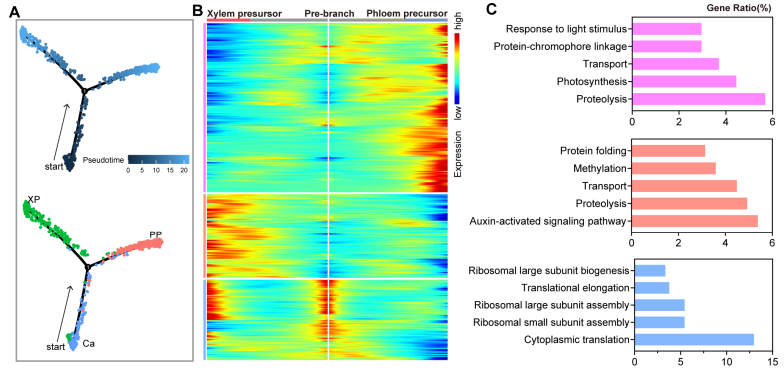The primary growth of the Populus tree depends on the division and differentiation of procambium, while the secondary growth is based on the division and differentiation of vascular cambium. Although they share some common biological properties, there are many differences between the vascular cambium and the apical meristem during secondary growth.
On July 24, 2023, Laigeng Li's team from the Chinese Academy of Sciences published an article entitled "Combining single-cell RNA sequencing with spatial transcriptome analysis reveals dynamic molecular maps of cambium differentiation in the primary and secondary growth of trees" in Plant Communications. This study reveals the molecular trajectory of cambium cell differentiation in primary and secondary growth of the Populus tree at the single-cell level.
In the present study, the authors first obtained single-cell gene expression profiles of primary and secondary growth tissues of the Populus tree. Cell type identification was performed based on cell-specific genes, and the accuracy and spatial localization of single cell types was determined by further obtaining stem spatial transcriptional maps. It is generally believed that WOX4 and PXY are cambium cell-specific genes. The results of the study found that two types of cells specifically expressed WOX4 and PXY, indicating that there were different types of differentiation initiation cells in the cambium, one differentiated into xylem fibers and vessel cells, and the other might develop into ray parenchyma cells.

Based on the identification of primary and secondary tissue cambium cells, the cambium, xylem precursor and phloem precursor cells were assembled together to construct a pseudo-time trajectory of cambium differentiation, and the expression profile of the process of differentiation of cambium into xylem and phloem precursors cells was obtained. By analyzing the branch-dependent genes of cambium differentiation in two directions, specific genes affecting the two directions of differentiation were found, and some genes showed obvious differentiation stage specificity. Further analysis found that the gene encoding auxin transporter was highly expressed during cambium differentiation, which may be related to the massive accumulation of auxin in cambium cells and differentiation stages.
After the differentiation of cambium cells to produce xylem precursor cells, a series of processes are required to form mature lignofibrous cells and vessel cells, including cell swelling, cell wall thickening, and programmed cell death. Through the subpopulation analysis of lignocellulosic and vessel cells, the gene expression profiles of different developmental stages of fiber and vessel cells were mapped, and a series of genes that may be involved in the regulation of fiber and vessel cell development were discovered, and the expression of these genes was verified by spatial transcriptome analysis.

Different from the primary growth in which the top of the stem grows upward, the secondary growth of the tree is based on the activity of the vascular cambium to generate secondary xylem, which makes the tree stem thicker. Wood formed through secondary growth is an essential renewable biomass resource for human society. Clarifying the gene expression profiles and molecular activity trajectories of cambium division and differentiation in the secondary growth process of trees provides a comprehensive and temporal understanding of the molecular processes of tree wood formation, and also provides a new molecular operation blueprint for cultivating fast-growing and high-quality forest trees.
Reference:
Li, R., et al. Combining single-cell RNA sequencing with spatial transcriptome analysis reveals dynamic molecular maps of cambium differentiation in the primary and secondary growth of trees. Plant Commun. 2023 Jul 24:100665.